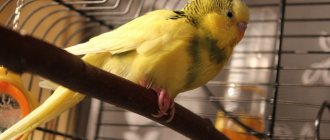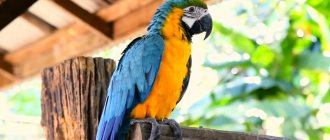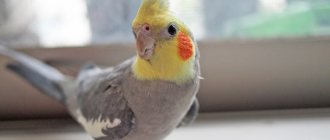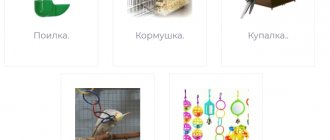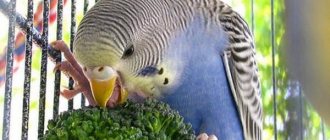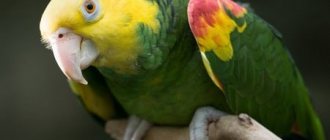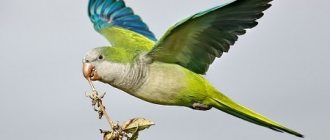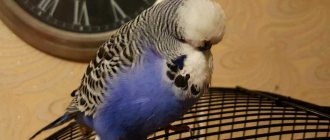Not all necklace parrots talk. This genus cannot be classified as birds that grasp words on the fly. There are also species among them that have no examples at all confirming their ability to reproduce human speech. If future sound communication is a priority for you when choosing a pet, then it is useful for you to know which species of necklace are capable of speech. Once you become familiar with the training technique, you can achieve the desired result from your parrot.
- The squeaky voice becomes pleasant
- The tongue is not involved in the conversation
- Friendships are most important
- First word
- The pet will be glad to see you
- You need to communicate live
- Don't say bad words
The squeaky voice becomes pleasant
Of the species of the necklace genus of parrots, the most talkative are the Indian Cramer's parrot and the Chinese. In nature, they live next door. Their habitats are indicated by their names - India and China. With timely and correct training, these birds can remember up to 100 words from the human vocabulary.
Other representatives - Mauritius, emerald, pink-headed, thread-tailed, Malabar, gray-headed - have not yet shown their abilities. In any case, there are no worthy examples of this.
Owners of necklace parrots note their unpleasant to hear, somewhat creaky voice. However, with mutual friendly communication, the owner very soon gets used to it and even begins to consider it quite beautiful and sonorous.
Population and status of necklace parrots
Necklace parrots are considered a widespread bird species. Most of them reproduce rapidly and their populations are increasing around the world. The most persistent of the family is called Indian Cramer's parrots. These birds adapt well to local living conditions, perfectly adapt to temperature changes and are unpretentious in their diet. Farmlands in Europe and the United States, located in the subtropical region, suffer from raids by these birds.
Other species behave less aggressively, but scientists also record a large increase in bird flocks in nature. The only one from the ringed family included in the Red Book as a species that is in danger of extinction is the Mauritian necklace parrot. The habitat of these birds is limited to the islands of Mauritius and Madagascar, which have become very popular among tourists recently. The development of local tourism requires the development of infrastructure, and this negatively affects the local flora and fauna. Cutting down trees where native ring-necked birds nested has led to a sharp decline in their numbers.
But the Seychelles, Rodrigues and Mascarene species were considered completely extinct. All attempts to find representatives of these populations for the purpose of reproduction, at least in captivity, have been futile. Birds have completely disappeared from the face of the Earth.
The tongue is not involved in the conversation
Before the necklace parrot speaks, the owner must hear it sing. Don't be upset if it seems terrible to you. As we said above, very soon your opinion will change. Keep in mind that if your parrot sings, your chances of learning to talk increase.
You should know that necklace parrots do not have vocal cords. The songs he performs and the words he subsequently pronounces are the result of air passing through the trachea, where sound is produced as a result of vibration of the walls of the lower part of the larynx.
It changes as a result of the work of special muscles that affect the size of the lumen in the bronchi. However, Indian and Chinese species have quite impressively sized tongues. It, of course, helps reproduction a little, but not to the same extent as for humans.
When you find your bird singing enthusiastically, treat it with a treat. Let the parrot know that if he sings, then his owner likes it. But if your pet screams heart-rendingly and rushes around the cage for no reason, then, on the contrary, show your displeasure. For example, leave the room, leaving the parrot alone. Let him be bored for half an hour.
Errors in learning
- Unsystematic activities. Irregular lessons do not bring the desired result, but lead to disappointment. The bird simply does not remember the material taught to it. Speech abilities simply do not develop with such an organization of classes.
- Conducting a lesson in a bad mood. This leads to psychological breakdowns in the teacher, which leads to stress for the parrot and loss of contact with him. And without contact with the student, no educational process is possible. It will simply turn into torment for both the teacher and the student.
- Use of punishments. The bird simply does not understand their meaning and they are interpreted as hostile actions. The result is rejection from the person. The planned result is unlikely to be fully achieved.
Friendships are most important
Before you start teaching your necklace parrot various words, you need to carry out appropriate preparation. Remember the following rules:
- the bird must be young (ideally three to six months);
- during classes the pet is kept alone in a cage;
- ensure that there is no extraneous noise (TV running, crackling, popping noises);
- the parrot must be healthy;
- friendly relations have been established between the owner and the pet;
- the necessary stage of taming has been completed;
- After 3-5 years, it is impossible to teach a necklace parrot to speak.
The key to success is the patience of the teacher. Therefore, tune in to a long process and do not expect immediate results. It may take more than one month before you hear the first word from your pet. The process of moving to real conversations can take up to a year.
How to make a pet tame?
It is very easy to accustom such a parrot to your hands (tame it). It is advisable to tame from an early age - up to three years. At this age, the bird not only quickly gets used to the owner and his hands, but also quickly learns onomatopoeia. How long might it take to tame? Depends on the bird, on average from a month to a year.
To do this, you need to approach the cage more often, talk to your pet more and gradually raise your hands to it. First, you can try to lure him with food, and only then the pet will get used to it and will sit in the owner’s arms.
First word
How to teach a necklace parrot its first word? To speed up training, start classes as soon as the bird has adapted and gotten used to its new home and its inhabitants. The first word that is usually taught is the pet's proper name. Try to keep it short and contain sounds that all parrots remember especially easily.
These are the hissing sounds “Ш”, “Ч”, “Ш”. Of the vowels, preference is given to the extended ones “A”, “O”, “I”, “E”. This may be why parrots are often called Kesha or Gosha. The consonants “K”, “R”, “P” and “T” are remembered quite well. From the entire set, you can always come up with a sonorous nickname that your pet will like. For example, Tika, Tosha, Richie, Corrie, Irka, Chateau, Papa, Shakti, etc.
It is difficult to guess what your necklace parrot's first word will be. We advise you to prepare several diverse short words, including his nickname. In this case, the bird itself will choose what it likes best.
Does a parrot's gender affect its ability to speak?
According to most bird trainers, it is believed that it is much easier to teach a boy the ability to pronounce words than a girl. This fact is confirmed by examples of a record vocabulary possessed by males. So the most sociable is the budgerigar Puck, who knew 1770 words. However, this does not mean that girls cannot “speak” at all. The exception is the female Australian parrot. To teach your budgie boy to talk, there are a few important things you should know.
The pet will be glad to see you
The necklace parrots were not observed to pronounce words and at the same time understand the meaning. Due to their development, birds simply remember frequently heard sounds. This is why you need to communicate and talk more with your pet.
It is best to conduct classes in the morning, while the parrot is not yet tired of the day's worries. Half an hour is enough for mutual communication. But your studies will become more productive if you spend half an hour 2-3 times a day.
Approach the cage and draw the parrot's attention to you. If contact has been previously established, he will be delighted to see you. Start a conversation by saying the chosen word several times in a row. Your intonations should be calm and always the same. At the slightest attempt by your pet to make a sound, encourage him and treat him with a treat.
If you find it difficult to come up with the right word, we suggest using our set from the table:
Do birds talk?
With the onset of spring, everyone enjoys the singing of birds. Parrots can not only chirp, producing delightful trills, but also repeat hundreds of different sounds, including human speech.
Can Parrots Talk?
For many years, scientists have been trying to figure out what exactly allows talking birds to imitate human speech so clearly.
It turns out that the whole point is in the so-called “singing centers” of the brain, which provide a close connection between the ability to reproduce sounds and the easy learning of birds. This process is called “mimicry”.
Surprisingly, according to scientific research, almost all species of ancient birds possessed these abilities. Igor Ignatenkov
Now the ability to speak is not inherent in all parrots. But necklaces are not included in this list, as they are easy to train.
You need to communicate live
It is not easy for a parrot to speak and, of course, it will not succeed right away. But your task is to support him in the desire to repeat something after you. During classes, you can use different words, but priority, that is, the most frequent repetition, is given to the word you are currently working on. Although, as a result, the parrot may be the first to say something completely different from what you were struggling with. There's nothing wrong with that, you'll just have to adjust your training later.
If you don't have enough time to spend with your pet, you can use an audio recording. But you should not abuse this method, since the bird can get used to communicating with itself. In the future, an already talking necklace parrot will not want to utter words in your presence.
Modern specialists often offer special training programs, but remember that no technology replaces face-to-face communication. Any electronic program can only be an addition.
Rules for teaching parrots to talk
Before you start classes, you need to understand a few nuances:
Rules that will help teach a parrot to talk
- You need to teach the Ozherelov only at the moment when the pet is as calm as possible.
- You cannot speak to him in a raised voice and insult the bird.
- Speech during class must be calm and measured, at an average pace, without harsh sounds.
- The same person must teach. It is advisable that it be a woman or a child, since birds learn high-pitched voices faster.
Next, you need to properly plan your lessons. You need to understand what each lesson should include. First of all, you need to choose words that are convenient for the bird. And learn that the most important thing in this process is regularity.
Don't say bad words
Once the necklace parrot has mastered the techniques of pronouncing words and phrases, it can continue its education on its own. And this will be done both with you and independently of you. Thanks to the ability to imitate the intonation of voices and the timbre of sounds, he can unexpectedly surprise you with the familiar voice of the host of a television program. It is also possible to repeat human speech that is distinguished by some kind of defect (burr, lisp, stutter). And listening to the patient cough too often, he himself will try to “cough.”
So be careful and don’t let your pet remember unwanted sounds and ugly words.
If you read the article with interest, please like it. Don't forget to send the link to your friends.
In the comments, please tell us about your own experience of teaching a necklace parrot to talk.
The developed brain of parrots makes possible all the versatility of their emotions: these birds can be caring and jealous, offended and curious, angry and inspired, demonstratively mischievous and having fun uncontrollably. In nature, birds communicate exclusively with each other, but the life of a tamed parrot is closely connected with humans - and no matter how hard the bird tries, sometimes its rich sound vocabulary remains misunderstood and therefore ignored... Owners of talkers should remember: any chirping, screaming and muttering is always carry a certain semantic load.
If a parrot tweets
The main sounds that a parrot makes include the “peak”, in which in the loudest phase it is easy to hear the “chivik”, reminiscent of a sparrow’s “chirp”. This is the first sound that chicks learn to pronounce when their voice just emerges: this is how they ask to feed them, to pay attention to them. Therefore, even in adulthood, this sound is usually associated with some kind of request from the bird. What the parrot wants to convey to its owner depends on the melody and volume of this sound. If the bird is ignored, the sound becomes louder and sharper.
"Pik" or "piu" said in a calmer tone is usually translated as a question asked calmly and patiently. For example, a bird may use such sounds if its cage is moved to another place for some reason. Or if the owners started rearranging the furniture in the room, the parrot may be slightly perplexed as to why everything is out of place. Or if a person appears in front of a pet in an unusual way - in large sunglasses or, say, with a colander on his head (you never know?)
Parrots are great explorers. They love to organize excursions to little-explored corners of your home and learn something unfamiliar to themselves. So in their vocabulary they have a special sound that the parrot utters without looking up from what it is doing, when it is very good and interesting. It usually sounds like a quiet “chivi-chivi-chivi”, and is repeated periodically after a pause.
In a calm state, a parrot can simply calmly “cheek” - as if whistling, thereby informing those around him that the situation is generally favorable for him, but there is not enough reason for a longer tirade.
If a parrot makes noise...
The parrot's sharp cries, which can be reproduced as “cha-cha! cha-cha!” have different meanings depending on the situation. The parrot may rebel and demand to be let out for a walk. He can “call” a bird he heard outside the window. He can also be excited about something, intrigued to the limit - many birds are brought into a kind of ecstasy by the loud rustling of cellophane and foil, the fall of a spoon or a stack of books from the edge of the table, and other “emergency incidents.” You can encounter such a cry even when the parrot is in an excellent, cheerful and even daring mood. Usually the screams are accompanied by an active cross around the cage, jumping onto the bars and flapping its wings.
Anyone who has ever tried to pick up an untamed parrot has encountered a heart-rending cry of “quack!” The sound can be frightened or indignant, and sometimes resembles a pig squealing. It signals that the parrot wants/demands that you leave it alone immediately. But a parrot makes a loud and sharp single squeak if it is in pain - for example, if it is pecked by another bird. This is, so to speak, a bird's “oh”.
Parrots are prone to both fun and some negative emotions. For example, a parrot, dissatisfied with the behavior of a person or a feathered partner, throws a scandal: it emits a very unpleasant “electric” chatter, which can be described as “piti-piti-piti” with a very elevated intonation, sometimes breaking into a final loud “peak”!
If a parrot sings and coos...
Most of the time, budgies are in a great mood, which they accompany by singing. The parrot takes a comfortable position, most often in front of a mirror or some prominent object such as a nail, a teaspoon, a curl of furniture or another parrot, and begins to sing. In this state, it is better not to touch the parrot - not to spoil its mood. And the song itself, although simple-minded, is quite pleasant to the ear.
Usually the parrot combines sounds arbitrarily, depending on its mood and creative drive. The combination of the sounds “chivik” (but deeper and more melodic) and “chak” gives rise to the famous trill, with which the parrot makes it clear that he is in a good mood and sees life in rosy tones. In general, it sounds like “tuyu-tuyu-tuyu-chuck, tuyu!” This may give the impression that water is babbling. Sometimes the song contains a clicking sound, which in itself is a sign of inspiration.
If a parrot is mumbling...
If the parrot is tired of its own fun, but not yet to the point that it wants to fall asleep, you can hear cooing sounds from it, such as those pronounced quietly and under your breath, with a closed beak, “kwe, kwe-e, kwe-e.” The intonation of sounds decreases. In a sleepy state, talking about how tired he is and how good he feels is reduced to a simple “kyo-yo-yo.”
The funny sound of a bumblebee’s purr, which can be reproduced as “grunt-grunt-grunt”, signals that there is some very pleasant and confidential conversation between two birds - they can feed each other or simply “rustle” with their beaks. Just don’t confuse good-natured grumbling with signs of illness - wheezing and shortness of breath, which occur in lethargic and disheveled birds with dull eyes and poor appetite (such a pet is definitely sick and urgently needs to be shown to a veterinarian).
If the parrot spoke...
As for “speaking,” which is beloved by its owners, this is a valuable additional way of communication for the bird. Most often, parrots speak in a good and calm mood, but they may miss a word or two in some emergency situations or out of place. It is no secret that feathered talkers know how to pronounce words at the right time: the remarkable intelligence of these birds allows them to competently use their vocabulary.
To simplify the task, you should always say the most important moments of interaction with the bird out loud - so that the parrot knows how, if necessary, to convey basic information to a person (eat, drink, swim, walk, home, hello, come to me, it’s time to sleep). This vocabulary can gradually expand - for example, a parrot will learn how to ask for its favorite treat (apple, banana, grass, etc.)
Oh yeah! Necklace parrots can scream. But not everyone yells and not always. The degree of loudness is determined by the character and preferences of each individual bird. It happens that at 6:00 in the morning the necklace parrot screams so much that it can be heard from the top floor all the way down the street.
And I want to calm him down as soon as possible. But how?
To silence a necklace parrot, you need to understand why it screams. And he yells most often when:
• Someone or something is also yelling. If you turn on the TV loudly, it will scream louder than the TV.
• He lacks attention and wants to attract it by shouting. Necklace parrots love communication. So if you are not ready to have frequent contact with the bird, then it is better not to get one. Otherwise, the parrot will loudly send cries into the air, which would mean: “SOS! Save, help! I'm bored!".
• He is dissatisfied with something. Your parrot may not like certain sounds or actions. For example, he may be very indignant if you imitate the sound of a horse clicking its shoes in front of him. My parrot can't stand this - he immediately starts screaming. Watch your pet and over time you will make your own list of what your parrot doesn’t like and what makes him start screaming loudly.
• He simply asks to fly. Necklace parrots do not tolerate confinement in a cage very well. We need to let them fly at least a little.
Accordingly, in order to stop a parrot from screaming, you need to eliminate the sources of irritation that make it scream (loud music, noisy dancing, screaming, etc.) But how to calm a bird down if it screams, and you don’t see any obvious reasons for this? There are several secrets. Remember:
1. Always! Do you hear?! Always cover the cage with a thin black cloth at night. The bird will understand that night has come and will not scream. And this night will last until you remove the fabric. If you don't cover the cage, your favorite parrot will most likely wake you up at first light. And not only you, but also your neighbors. Everyone should know that morning has come! The fabric should be thin so that air can freely penetrate into the cage and the bird does not feel stuffy. Also make sure that the fabric completely covers the cage to the very bottom. If you leave a small part uncovered, the bird will understand that it is being fooled (it is still light outside and you can bawle songs). Necklace parrots are very intelligent.
2. What to do during the day? Yes, it would be somehow wrong to make the bird night during the day. But there is a very effective way: occupy her beak with something tasty. An excellent option is walnut. But the nut is not peeled, but split into two halves. The bird will have to sweat to get the treat from the shell - you are guaranteed at least half an hour of silence. But remember that giving your parrot too many nuts is contraindicated. They are very fatty. I give mine a maximum of 1.5 nuts a day.
3. The Internet rules - even parrots love it. Play a video on the Internet for a necklace parrot where his relatives speak human language, and he will become quiet. He will sit quietly and listen! Moreover, frequent viewing of such videos can teach the bird human speech. Tested from my own experience. My parrot spoke like this.
4. Speak quietly and measuredly. Necklace parrots are designed this way: the louder you talk, the louder they scream. And if you turn up the music at full volume, believe me, the parrot will try to shout over it. And, most likely, he will succeed. So maintain a calm environment at home. Gradually, the bird will get used to it and will try not to violate the volume standards established in your home. If you yourself shout and express negativity, the bird will only get even more excited and will shout down you.
5. Let the bird fly. Outside the cage, necklace parrots rarely scream, since they have a lot of other more interesting things to do - chat with the owner, talk to the reflection in the glass, play with toys, watch videos on the owner’s smartphone, etc. Of course, you will have to make sure that your feathered pet does not misbehave. But he will definitely appreciate your trust and kindness and will respond in kind.
And most importantly, love your pet. Strength and aggression will not achieve anything from parrots.
Only love and patience can turn a wild, noisy parrot into the most affectionate and calm bird that will give you a lot of joy and warmth.
Parrots are one of the species of the large parrot family. Representatives of this species include such popular birds among bird lovers as:
- Alexandrian necklace parrot.
- Indian ringed parrot.
- Blue-necked parrot.
It is these representatives of the Ozherelov family that have recently become the most popular among home collectors.
Taming
After the parrot calms down and begins to be active in behavior and eating food, a period of taming begins. The owner’s main goal at this time is to inspire confidence in himself. Taming a parrot is a long process that requires patience and careful attention to the bird .
The most effective way to interest a parrot and gain its trust is to feed it a treat. Pet stores sell special food for this type of bird.
In addition to them, you can give:
- pieces of sweet fruit;
- fresh herbs;
- raw vegetables.
If the bird is afraid of the hand, pieces of food are attached to a toothpick or cocktail straw and the food is pulled through the bars of the cage. Gradually the parrot will get used to its owner and will no longer be afraid of his hands.
Parrots remember grievances. They can forgive the bad attitude of the owner with whom they have lived next to for many years. But the new owner will be shunned for a long time.
How to hand train a budgie
Budgerigars begin to be tamed in the same way: with the help of treats. Gradually, the bird will get used to it and will begin to receive only positive emotions from the presence of its owner. The easiest way to gain trust is with young individuals. It’s more difficult with adults; they can be wary of the new owner for a long time. But you can get along with them too. There are several ways to make contact:
- speak kindly;
- delicious food;
- choose the right moments for communication: the bird should be active, not drowsy, not frightened.
If you are unable to attract your pet’s attention with a treat, you need to carefully watch him for a while . It is important to understand his character, what he likes to do at a time when he believes that no one is watching him. Many budgies love to swing on a perch or ring a bell.
If the bird does not have a favorite toy, they put a variety of things in the cage: balls, colored pieces of paper, beautiful stones. When the parrot becomes interested in one of them, the taming process begins. Gradually move your favorite toy towards your hand, thereby forcing the bird to climb onto your finger. Daily training will certainly lead to the desired result.
How to tame a necklace parrot
The Ruffed Parakeet is a bird with character. In his taming, much depends on age and upbringing. If the parrot is older than three years, all the owner’s tricks regarding taming may be useless . An adult bird can remain “wild” forever.
The methods for raising a necklace parrot are the same:
- gaining trust;
- feeding with treats;
- hand training.
Birds of this breed understand and remember intonations very well. They always recognize a fake. Therefore, taming classes are carried out in moments of good mood and with a sincerely affectionate attitude towards the bird.
Taming stages:
- They are taught to calmly react to the owner's hand next to the cage. At this stage, the palm should be motionless. At the same time, with your second hand you can offer a treat on a toothpick or any other long stick. They talk kindly.
- Slowly bringing the hand closer to the cage, they begin to move their fingers. If this does not frighten the bird, continue to accustom it to the hand. If the parrot is alarmed, stop moving their fingers. After some time the attempt is repeated.
- Place your hand in the cage and repeat the training process.
- Place a treat on your palm and offer it to the parrot. Repeat until the bird gets used to it and starts eating food.
- Move the treat closer to the middle of the palm, forcing the parrot to move along the hand.
Necklaces are one of the few breeds of parrots that can live in the wild and earn their own food. By their nature, these are typically “aviary” birds. The most amenable to training are those raised by their parents. Adults caught in the wild may not make contact with humans for the rest of their lives.
When it comes to taming a parrot, communication is most effective when it is outside its cage . You should not try to approach him or gradually reduce the distance, since, obeying instinct, he will fly away. The Ruffed Parrot needs to be interested in a toy or treat.
Taming a lovebird
There is one peculiarity in taming lovebirds - these birds consider the territory of the cage to be theirs and actively defend it . If the parrot is not yet used to it and does not trust its owner, it may peck the hand extended into the cage. But the reason for this behavior may lie not only in the natural wariness of the bird.
Lovebirds often calmly sit on the owner's shoulder, but may not go into their arms. Perhaps the bird is scared by the previous owner, employees or visitors of the pet store. Fear of hands can also be caused by the fact that the bird was caught with them, and not with a net.
In this case, you need to try very hard to inspire absolute trust. As a rule, with proper persistence, several months are enough for this.
Favorite treats of lovebirds:
- carrot;
- apple;
- grape;
- Bell pepper.
The methods for taming lovebirds are no different from those listed above.
We accustom the Rosella parrot to hands
Rosellas are intelligent parrots, with an easy-going nature, but cautious. They are more difficult to get used to humans than budgies and lovebirds.
The basic principles of communication with Rozelle are the same:
- gradualism;
- weasel;
- no sudden movements;
- regularity of attempts.
You can use their natural curiosity to tame a parrot . In this case, not only food is placed on the palm, but also some bright, shiny object. Over time, the bird will overcome its fear and begin to stand on the palm, first with one paw, and then with both.
Appearance
These birds are very beautiful. Most representatives have green plumage, with minor splashes of other shades. Representatives of the blue-necked parrot have blue plumage. On the body of these birds, there is one characteristic feature that separates them from representatives of other species of the family - a multi-colored stripe bordering the neck. It is because of this that representatives of the species were called necklaces.
The color of the stripe is different for representatives of different species of necklaces.
Height and weight
Birds belong to the category of medium-sized parrots. Their length ranges from 30 to 60 millimeters. The body weight of zherelovids is from 110 to 125 grams.
Video lessons: how to quickly teach a parrot to talk
Correspondents of the TV show “Guberniya” decided to find out how to teach a bird to have intimate conversations. It turned out that the ability to speak is different in all species of these birds. The study found that a cockatoo can only learn 30 words, while a Gray Gray can learn up to a thousand words. The most important point in training is communication with your pet. The use of technical means - a voice recorder or tape recorder - increases the effectiveness of classes. You can learn more about training parrots by watching the following online stories:
Easy ways to teach a parrot to talk
How to teach a parrot to talk. Wavy, Cockatoo, Gray.
Spreading
Lives in two parts of the world - Asia and Africa. Its representatives can often be found in South Asia and the African tropics.
A representative of the Ozherelov species, the Indian ringed parrot has the widest distribution among the parrot family. He lives in two parts of the world - Asia and Africa.
In Asia, it is found in India, Pakistan, Nepal, Ceylon, and Myanmar. In Africa, it lives in the lands of Nigeria, Ghana, Burkina Faso, Chad, Ethiopia, Cameroon, Djibouti, Uganda, and Ethiopia.
Diet
Natural food for these birds is all kinds of seeds, vegetables and fruits. A fairly powerful beak allows it to pierce the shell of various fruits, removing and eating their pulp and seeds.
The diet in captivity should be as similar as possible to the natural diet. This means that the feeder must have:
- Seeds and grains.
- Fruits.
- Vegetables.
Duration and lifestyle
At home, the necklace parrot lives up to 25 years. Some experts believe that these birds can live 40 and 50 years. In the wild, life expectancy decreases sharply for a number of reasons:
- Habitat degradation due to deforestation.
- A large number of predatory animals that love to feast on them.
- Poaching.
They prefer to nest in the hollows of tall trees growing in forests. They live in large groups, which can number tens or hundreds of individuals. Early in the morning they fly out in search of food. During lunch they take a short break for rest and sleep. After the break, the search for pasture continues. In the evening they fly to their permanent nesting sites, where they spend the night.
Character and intelligence
By nature, these representatives of birds are sociable, calm and very obedient to their owner. The pets happily greet him every time after a long absence. They rarely show aggression. The owner does not need to fear that the bird will suddenly attack him.
Very curious. Sometimes this can lead to negative consequences. Out of curiosity, they can accidentally damage their beak by hitting it hard on the bars of the cage, break the electrical cable, or peck at things the owner needs.
They love toys. They are especially attracted to small mirrors, into which they can look for hours, admiring their images. It is advisable to hang mirrors within easy reach.
They have a negative attitude towards other feathered pets. They may be aggressive towards those who:
- Weaker and smaller than them.
- Same gender as them.
They immediately try to take a dominant position in relation to other poultry, and do not allow the latter to approach the drinking bowl, feeder, or toys.
Therefore, they can only be kept together in the same cage with equally strong representatives of the species or representatives of larger species that will not allow themselves to be pushed around.
The intellectual level is quite high. They are able to remember and reproduce the sounds of other birds, as well as human speech. Vocabulary varies depending on the species to which the ringtailed parrot belongs. Some species can reproduce up to 60 words, others up to 250. But we must remember that there are species that cannot reproduce human speech at all. The clarity and clarity of their speech depends on individual abilities, as well as the patience and skill of the person who wants to teach the necklace parrot to talk.
How to learn to speak correctly
There is a fairly stable stereotype that only a male necklace can be taught to talk. This statement is not true - females can also be trained, but require more effort and patience. But the first results of persistent training will please you: the diction of the females is better, they usually pronounce the first words and even phrases more clearly than the males.
There are several rules and recommendations that will make it easier for you to teach your bird to pronounce certain words and phrases.
- Lessons should take place not when you want it or have free time, but in moments of complete calm for your pet. This is a necessary and most important condition - an aggressive, anxious or any other unbalanced state not only interferes with classes, but can cause the bird to become withdrawn, after which it will generally remain silent all the time.
- You need to communicate with birds calmly, measuredly, and without rushing. Your diction should be extremely legible, without sharp sounds or tonal changes.
- Rudeness, “bad” words, insulting a pet, speaking in a raised voice or threats are unacceptable. Remember that the Parrot family is one of the smartest representatives of the class of birds.
- The timbre of the sounds produced by the Indian ringtail is quite high, and is closer to a woman’s voice than to a man’s. So the bird better perceives the lessons of learning human speech taught by a woman or child. In addition, there should only be one teacher.
Any more or less successful attempt by your pet to repeat a word you have spoken should be encouraged. Select a few simple, clearly sounding words that you will repeat 15–20 times in one lesson. In addition, try to use them in everyday life in the presence of your ward.
Important! Parrots begin to speak faster when near a mirror. But it is better to use polished metal rather than a real, traditional device.
Try to first focus on words that contain sounds that the parrot reproduces better than others. Most often these are “o” and “a”, “t”, “p”, “k” and “p” and almost all are sibilant. It is for this reason that among the names that these pets are often called, there are such as Kesha, Nyusha, Pasha, Lyosha, etc.
Keeping at home
Keeping these parrots at home is accessible even to novice hobbyists. Breeders just need to follow the rules and pay attention to some important points. If all instructions are followed as much as possible, the necklace pet will live in a cage for a long time and delight its owner.
Selecting a cage and accessories
The first crucial moment is the selection of the optimal cage for keeping. It must meet certain criteria. Firstly, its size must be at least 1x2 meters. The fact is that any type of necklace parrot, be it Mauritian, Indian, Alexandrian or blue, loves space. In a small cage, birds experience serious discomfort, which negatively affects the quality and duration of life.
Secondly, the cage must be made of durable and environmentally friendly materials - wood, modern environmentally friendly plastic, metal. Keeping a pet in a cage whose elements are made of cheap materials that emit harmful substances is unacceptable.
Thirdly, the cage itself must be made of high quality. All sorts of burrs or protruding small nails in the cage can be extremely dangerous for the bird, on which it can be injured.
In addition to the above, cage equipment is extremely important. It should have a feeder and a sippy cup. In addition to them, the presence of perches is mandatory. It is highly desirable if there are several of them. In this case, it is better to place them at different levels, but so that they are not located strictly one above the other.
The bird can jump from one to another and, thus, exhibit motor activity, which is important for any domestic animal. The same requirements apply to perch materials as to cage materials. In addition to the perches, you can place a system of ladders and rings.
Preparing a balanced diet
Proper feeding of a feathered pet is one of the keys to its long and prosperous life. It is advisable to feed him the food that he eats in the wild. First of all, this type of food includes grain.
Therefore, there should always be a grain mixture in the feeder.
It can be made based on:
- Millet grain.
- Oats.
- Canary seeds.
- Sunflower.
Parrots react very positively to various nuts. They love to break through nut shells and get out all the insides, which are then eaten by birds.
The right solution would be to use food additives in the form of vegetables and fruits (tangerine, orange and other citrus fruits). Parrots eat all this in their natural environment.
Therefore, vegetables and fruits are natural food for pets.
Bathing
Initially, washing should consist of carefully spraying the young pet with a spray bottle. The water must be warm. After some time, you can transfer the chick to a full bath. For this purpose, you can use a separate container filled with water about 2-3 centimeters deep.
Education and training
For the first few days of the acquired chick, it is better not to disturb it unnecessarily. The pet has not yet adapted to the new conditions and is experiencing stress. There should always be food and water in the cage. To accustom the chick to your hands, you need to put food on your palm. Usually after 2-4 days the chicks calmly feed from the owner’s hands.
After the chick is tamed, speech training can begin. To do this, you need to take the chick in your arms 2-3 times a day and, raising it to your lips, pronounce phrases loudly and clearly. After a few weeks, the pet will begin to repeat them. The chick should be no more than 3-4 months old.
Diseases and prevention
The main cause of disease is improper care of your pet. Their main external signs are changes in behavior, such as:
- Lethargy.
- Apathy.
- Rapid and intermittent breathing.
- Sleeping on two legs.
If these symptoms are present, it is better to immediately show your pet to a veterinarian to establish a diagnosis and develop a treatment algorithm.
Proper care is the basis for preventing diseases in parrots.
Tips and tricks when purchasing
Before you decide to get a bird, you need to weigh the possibilities.
The pet will need to provide:
- spacious home;
- fresh and varied food;
- toys, exercise equipment;
- quality drinking water;
- give the opportunity to fly around the apartment every day.
You will need to set aside time to communicate with the bird, teach words and tricks, and monitor the health and cleanliness of the cage.
These parrots are purchased from pet stores or nurseries. Prices depend on the origin, sex and color of the bird. Only a specialist can determine the sex of a necklace parrot.
When purchasing, you need to pay attention to the fact that the bird is active, shows active participation, curiosity towards others and has a good appetite.
Reproduction
The process is generally similar to that of other species, but has a number of individual characteristics.
Preparatory procedures
Sexual maturity is reached at 3-4 years. During the mating season, adult birds create pairs. They are stable, but at the same time, partners do not always stay together all their lives.
After mating, they make nests in the hollows of old trees.
Laying eggs and caring for chicks
Egg laying takes 1-2 days. Their number usually does not exceed 4, although according to some data it can reach up to 6. Only the female incubates the eggs. This process lasts 22-24 days. Like other species of parrots, chicks at the beginning of life are completely dependent. The chicks remain in the nest for 6-7 weeks.
Determination of gender
Up to 3 years of age, gender can only be determined with 100% accuracy using a special analysis. There are several indirect ways to distinguish a boy chick from a girl. A few words need to be said about each of them.
By color and dark ring around the neck
Females are more dull in color. They do not have a “necklace” - a black and pink stripe around the neck.
According to the shape and size of the head, beak
The head of females is more rounded than that of males. The latter are also distinguished by a more saturated color of the cheeks and beak.
By the paws
The paws of female chicks are slightly more powerful and larger than the paws of males. The legs of female birds themselves are somewhat thicker and shorter than those of male chicks.
Tail length
The tail of a male pet is usually slightly longer than that of a female.
By behavior
You need to place a small mirror in the cage and watch your pet. Males, seeing their reflection, begin to show beauty - they constrict their pupils and open their wings. Female chicks behave differently - they tilt their heads back and constrict their pupils in the same way.

